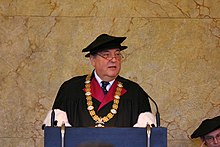The Eindhoven University of Technology, abbr. TU/e, is a public technical university in the Netherlands, situated in Eindhoven. In 2020–21, around 14,000 students were enrolled in its BSc and MSc programs and around 1350 students were enrolled in its PhD and EngD programs. In 2021, the TU/e employed around 3900 people.
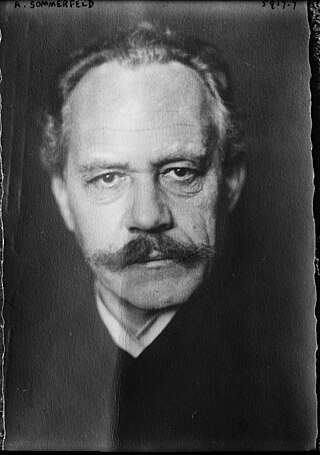
Arnold Johannes Wilhelm Sommerfeld, was a German theoretical physicist who pioneered developments in atomic and quantum physics, and also educated and mentored many students for the new era of theoretical physics. He served as doctoral supervisor and postdoc supervisor to seven Nobel Prize winners and supervised at least 30 other famous physicists and chemists. Only J. J. Thomson's record of mentorship offers a comparable list of high-achieving students.

The University of Innsbruck is a public research university in Innsbruck, the capital of the Austrian federal state of Tyrol, founded on October 15, 1669.

Graz University of Technology is a public research university located in Styria, Austria. It was founded in 1811 by Archduke John of Austria and is the oldest science and technology research and educational institute in Austria. It currently comprises seven faculties and is a public university. It offers 19 bachelor's and 35 master's study programmes across all technology and natural sciences disciplines. Doctoral training is organised in 14 English-speaking doctoral schools. The university has more than 16,000 students, and around 1,800 students graduate every year. The Graz University of Technology and the University of Graz co-operate in teaching and research of natural sciences.
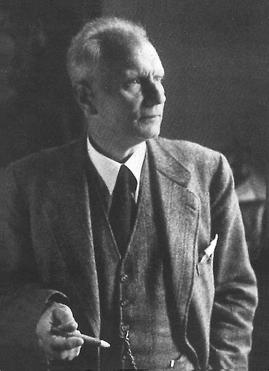
Walther Gerlach was a German physicist who co-discovered, through laboratory experiment, spin quantization in a magnetic field, the Stern–Gerlach effect. The experiment was conceived by Otto Stern in 1921 and successfully conducted first by Gerlach in early 1922.

The Vienna University of Technology is a public research university in Vienna, Austria.

The University of Leoben is a public university in Leoben, Styria, Austria. It was established on 4 November 1840 as the Steiermärkisch-Ständische Montanlehranstalt in Vordernberg, Styria, Austria's mining region. In 1849 Peter Tunner relocated the university to nearby Leoben. That year the university had a mere 48 students enrolled.

Peter Zoller is a theoretical physicist from Austria. He is professor at the University of Innsbruck and works on quantum optics and quantum information and is best known for his pioneering research on quantum computing and quantum communication and for bridging quantum optics and solid state physics.

Juan Ignacio Cirac Sasturain, known professionally as Ignacio Cirac, is a Spanish physicist. He is one of the pioneers of the field of quantum computing and quantum information theory. He is the recipient of the 2006 Prince of Asturias Award in technical and scientific research.

Ivan Nikolov Stranski was a Bulgarian and later a German physical chemist who is considered the father of crystal growth research.
The Wittgenstein Award is an Austrian science award supporting the notion that "scientists should be guaranteed the greatest possible freedom and flexibility in the performance of their research." The prize money of up to 1.5 million euro make it the most highly endowed science award of Austria, money that is tied to research activities within the five years following the award. The Wittgenstein-Preis is named after the philosopher Ludwig Wittgenstein and is conferred once per year by the Austrian Science Fund on behalf of the Austrian Ministry for Science.
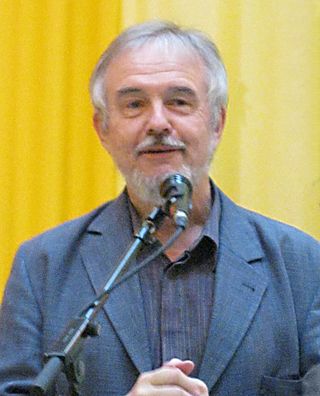
Peter Planyavsky is an Austrian organist and composer. He attended the Schottengymnasium. After graduating from the Vienna Academy of Music in 1966 he spent a year in an organ workshop, and has been instrumental in organ-building projects, notably the construction of the Rieger organ in the Great Hall of the Wiener Musikverein. In 1968 he was appointed organist in the Upper Austrian Stift Schlägl, and the following year organist at Vienna's St. Stephen's Cathedral. From 1983 until 1990 Planyavsky was their director of music, with overall responsibility for church music at the cathedral.

Peter Frankenberg is a German researcher, professor and politician (CDU). Frankenberg was Minister of Science, Research and the Arts of the state of Baden-Württemberg from 2001 to 2011. Previously he was chaired professor and President (rector) at the University of Mannheim from 1994 until 2001.
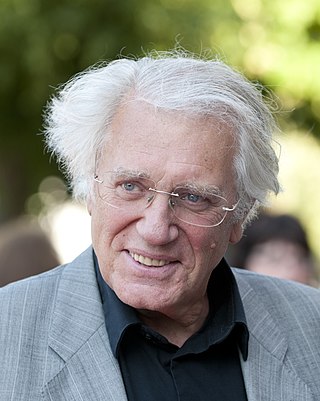
Rudolf Streicher is a former Austrian politician. He served in the government of Austria as Minister of Transport and Economy from June 1986 to April 1992. Streicher is a member of the Social Democratic Party of Austria (SPÖ).

Ulrike Diebold is an Austrian physicist and materials scientist who is a professor of surface science at TU Vienna. She is known for her groundbreaking research on the atomic scale geometry and electronic structure of metal-oxide surfaces.

Axel Freimuth is a German physicist. On 1 April 2005 he succeeded the mathematician Tassilo Küpper as Rector of University of Cologne. His initial appointment was for a term of four years but this has subsequently been extended.

Universities Austria is an advocacy organisation that supports research universities in Austria and promotes science, art, and research. It was founded in 1911. In 2008, it changed its name from Österreichische Rektorenkonferenz to Österreichische Universitätenkonferenz.
Ina Wagner is an Austrian physicist, computer scientist and social scientist. She is an emeritus professor of computer science at TU Wien (Vienna), where she was active from 1987 until 2011.
Silke Bühler-Paschen is a German-Austrian solid-state physicist and has been professor for physics at TU Wien, Austria since 2005.
Hellmut Friedrich Fischmeister was an Austrian metallurgist who was a pioneer in powder metallurgy.
